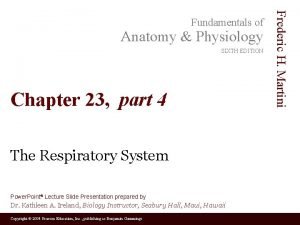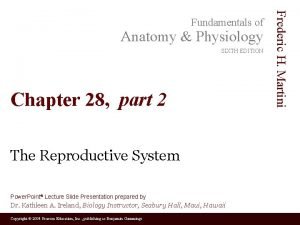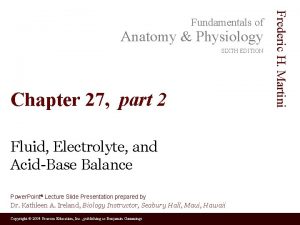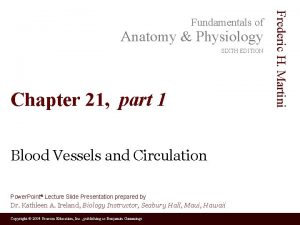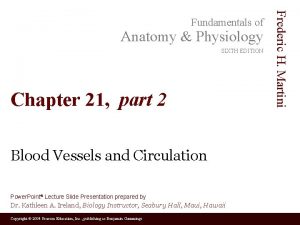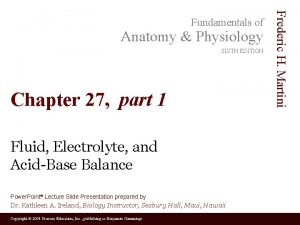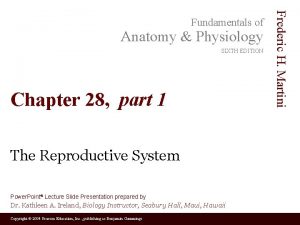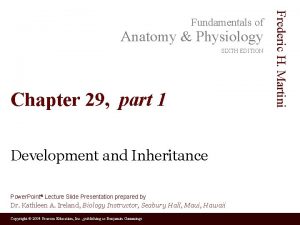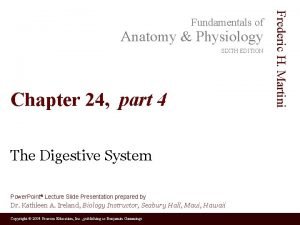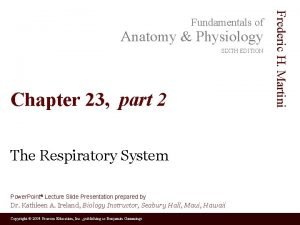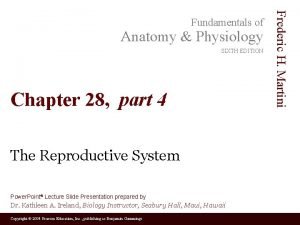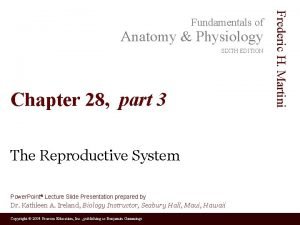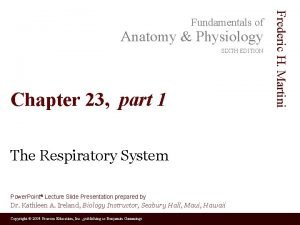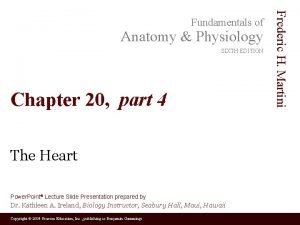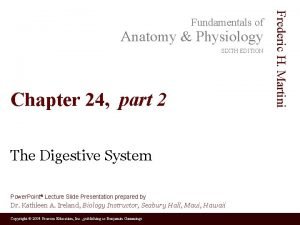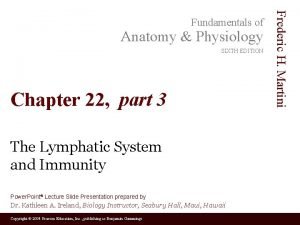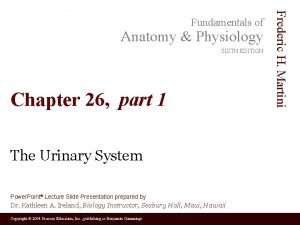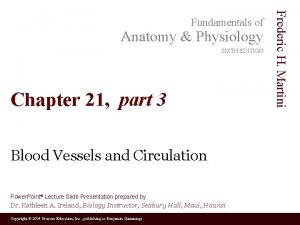Anatomy Physiology SIXTH EDITION Chapter 26 part 4



















- Slides: 19

Anatomy & Physiology SIXTH EDITION Chapter 26, part 4 The Urinary System Power. Point® Lecture Slide Presentation prepared by Dr. Kathleen A. Ireland, Biology Instructor, Seabury Hall, Maui, Hawaii Copyright © 2004 Pearson Education, Inc. , publishing as Benjamin Cummings Frederic H. Martini Fundamentals of

SECTION 26 -6 Urine Transport, Storage, and Elimination Copyright © 2004 Pearson Education, Inc. , publishing as Benjamin Cummings

Urine production ends with fluid entering the renal pelvis • Rest of urinary system transports, stores and eliminates • Ureters • Bladder • Urethra Copyright © 2004 Pearson Education, Inc. , publishing as Benjamin Cummings

Figure 26. 17 A Radiographic View of the Urinary System Copyright © 2004 Pearson Education, Inc. , publishing as Benjamin Cummings Figure 26. 17

The ureters • Pair of muscular tubes • Extend from renal pelvis to the bladder • Peristaltic contractions force urine toward the urinary bladder Copyright © 2004 Pearson Education, Inc. , publishing as Benjamin Cummings

The urinary bladder • Hollow, muscular organ • Reservoir for the storage of urine • Contraction of detrusor muscle voids bladder • Internal features include • Trigone • Neck • Internal urethral sphincter • Ruggae Copyright © 2004 Pearson Education, Inc. , publishing as Benjamin Cummings

Figure 26. 19 Organs for the Collection and storage of Urine Copyright © 2004 Pearson Education, Inc. , publishing as Benjamin Cummings Figure 26. 19 a

Figure 26. 19 Organs for the Collection and storage of Urine Copyright © 2004 Pearson Education, Inc. , publishing as Benjamin Cummings Figure 26. 19 b

Figure 26. 19 Organs for the Collection and storage of Urine Copyright © 2004 Pearson Education, Inc. , publishing as Benjamin Cummings Figure 26. 19 c

The urethra • Extends from the urinary bladder to the exterior of the body • Passes through urogenital diaphragm (external urinary sphincter) • Differs in length and function in males and females Copyright © 2004 Pearson Education, Inc. , publishing as Benjamin Cummings

Figure 26. 20 The Histology of the Organs that Collect and Transport Urine Copyright © 2004 Pearson Education, Inc. , publishing as Benjamin Cummings Figure 26. 20 a

Figure 26. 20 The Histology of the Organs that Collect and Transport Urine Copyright © 2004 Pearson Education, Inc. , publishing as Benjamin Cummings Figure 26. 20 b, c

Micturition reflex and urination • Urination coordinated by micturition reflex • Initiated by stretch receptors in wall of bladder • Urination requires coupling micturition reflex with relaxation of external urethral sphincter Copyright © 2004 Pearson Education, Inc. , publishing as Benjamin Cummings

Figure 26. 21 The Micturition Reflex Copyright © 2004 Pearson Education, Inc. , publishing as Benjamin Cummings Figure 26. 21

Figure 26. 21 The Micturition Reflex Copyright © 2004 Pearson Education, Inc. , publishing as Benjamin Cummings Figure 26. 21

SECTION 26 -7 Aging and the Urinary System Copyright © 2004 Pearson Education, Inc. , publishing as Benjamin Cummings

Changes with aging include: • Decline in the number of functional nephrons • Reduction of GFR • Reduced sensitivity to ADH • Problems with the micturition reflex Copyright © 2004 Pearson Education, Inc. , publishing as Benjamin Cummings

You should now be familiar with: • The components of the urinary system and their functions • The location and structural features of the kidneys • The structure of a nephron, and the processes involved in the formation of urine • The normal characteristics, composition, and solute concentrations of a representative urine sample Copyright © 2004 Pearson Education, Inc. , publishing as Benjamin Cummings

You should now be familiar with: • The factors that influence filtration pressure and the rate of filtrate formation • The types of transport mechanisms found along the nephron • How antidiuretic hormone and aldosterone levels influence the volume and concentration of urine Copyright © 2004 Pearson Education, Inc. , publishing as Benjamin Cummings
 Human anatomy and physiology seventh edition marieb
Human anatomy and physiology seventh edition marieb Human anatomy & physiology edition 9
Human anatomy & physiology edition 9 Paratubular cyst
Paratubular cyst Peter piper tongue twister
Peter piper tongue twister Rubber baby buggy bumpers tongue twister lyrics
Rubber baby buggy bumpers tongue twister lyrics Chapter 14 anatomy and physiology
Chapter 14 anatomy and physiology Waistline
Waistline Anatomy and physiology chapter 8 special senses
Anatomy and physiology chapter 8 special senses Chapter 13 anatomy and physiology of pregnancy
Chapter 13 anatomy and physiology of pregnancy Chapter 2 basic chemistry anatomy and physiology
Chapter 2 basic chemistry anatomy and physiology Anatomy and physiology chapter 7
Anatomy and physiology chapter 7 Art labeling activity: figure 14.1 (3 of 3)
Art labeling activity: figure 14.1 (3 of 3) Chapter 10 blood anatomy and physiology
Chapter 10 blood anatomy and physiology Anatomy and physiology chapter 15
Anatomy and physiology chapter 15 Anatomy and physiology chapter 1
Anatomy and physiology chapter 1 Holes anatomy and physiology chapter 1
Holes anatomy and physiology chapter 1 Anatomy and physiology chapter 15
Anatomy and physiology chapter 15 Distal and proximal
Distal and proximal Chapter 2 human reproductive anatomy and physiology
Chapter 2 human reproductive anatomy and physiology Pectoral girdle acetabulum
Pectoral girdle acetabulum




















